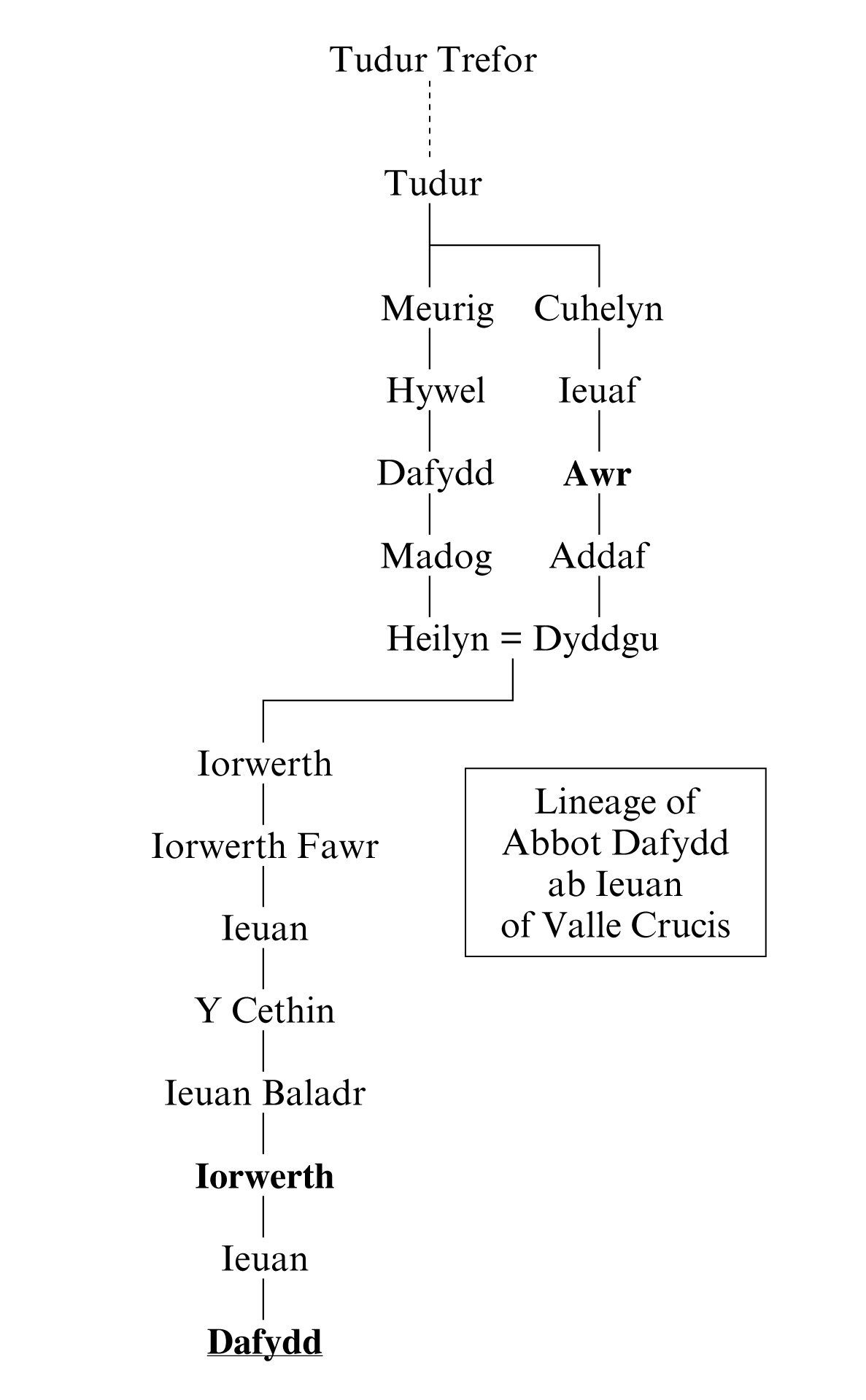A total of eleven poems by Guto for Abbot Dafydd ab Ieuan have survived in the manuscripts. It seems that Dafydd was the poet’s principal patron in his old age. He addressed four poems of praise and one poem of thanks to the abbot directly:
- two cywyddau of praise (poems 112 and 117);
- two odes of praise (poems 111 and 113);
- a poem of thanks for a buckler (poem 110).
Dafydd is referred to in six other poems:
- a poem Guto composed to defend his place in Valle Crucis in which Dafydd is praised (poem 116);
- a religious meditation that Guto composed following a rebuke by Dafydd (poem 118);
- a poem of praise for Abbot Dafydd ab Owain of Strata Marcella that Guto composed at Dafydd’s request, in all likelihood (poem 115);
- a poem to request the Book of the Grail from Trahaearn ab Ieuan of Pen-rhos on Dafydd’s behalf (poem 114);
- a poem to request eight oxen from Dafydd, Siôn Trefor ab Edward of Pentrecynfrig, Siôn Edward of Chirk and Dafydd Llwyd ap Tudur of Bodidris on behalf of Rhisiart Cyffin, dean of Bangor (poem 108);
- a poem to thank both Dafydd and Rhisiart Cyffin, dean of Bangor, for healing a wound (poem 109).
It is likely that Guto’s last poem (poem 119) was composed in Valle Crucis when Dafydd was abbot, as was Gutun Owain’s elegy for Guto (poem 126; cf. a reference to Guto in XXV.9–10). Indeed, Gutun composed eight other poems of praise for Dafydd:
- four cywyddau of praise (GO poems XXIV, XXVIII, XXIX, XXX);
- three odes of praise (ibid. poems XXV, XXVI, XXVII);
- an awdl-gywydd (ibid. poem XXXI).
Only one other poet can be associated with Dafydd, namely Tudur Aled, who referred to the abbot in a poem composed for one Rhys who had gifted Dafydd with a horse (TA poem LXIX).
Lineage
The genealogical table below is based on WG1 ‘Tudur Trefor’ 1, 2. Those named in Guto’s poems for Dafydd are shown in bold print. Their relative absence in Guto’s poetry is noteworthy.

Lineage of Abbot Dafydd ab Ieuan of Valle Crucis
His career
It is likely that Dafydd was born in Trefor in the parish of Llangollen. His mother does not appear in the genealogies, probably because Dafydd was born out of wedlock. Like his contemporary, Rhisiart Cyffin, dean of Bangor, Dafydd had to acquire a dispensation on account of illegitimacy to hold an ecclesiastic office. He was made a monk like his father, Ieuan. We learn from the poetry of Guto’r Glyn and Gutun Owain for him that he had dark hair (110.4 angel du ‘black-haired angel’; 112.19 [g]ŵr gloywddu ‘a man with shining black hair’; 113.77 du llawenddoeth ‘a jovial and wise black-haired man’; GO XXXI.23).
In 1480 he succeeded Abbot Siôn ap Rhisiart as abbot of Valle Crucis, and in 1485 he was appointed deputy to the Cistercian abbots of both Fountains in Yorkshire and Woburn in Bedfordshire in the work of reforming the order in Wales and England. In the same year he was appointed by Henry VII to head a group of researchers, including Gutun Owain and Sir Siôn Leiaf (see 116.11–12n), in the work of creating the king’s Welsh lineage. By 1496 he was also warden of the collegiate and parochial church of St Peter in Ruthin, and he was allowed to retain both that office and his abbacy when he was appointed bishop of St Asaph on 8 January 1500. However, his bishopric was short-lived, for he died towards the end of 1503.
Unlike his successor as bishop, Abbot Dafydd ab Owain, no poems for Dafydd have survived from his period as bishop. The highpoint of his career was undoubtedly his abbacy, and his success as abbot is made abundantly clear in the poetry composed for him. It is known that Abbot Dafydd ab Owain, who was abbot of Strata Florida, Strata Marcella and Aberconwy, was educated in Oxford, yet nothing is known about Dafydd ab Ieuan’s education. However, the poetry clearly shows that he was a learned man (112.29–30; poem 114; GO XXIV.29–30, XXV.19, XXVIII.45) and that he was well versed in both the poetic craft and music. Guto refers to him as a diwael brydydd ‘a fine bard’ who can also play musical accompaniment like the famous harpist, Brido (113.58–60; cf. GO XXIV.39–40, XXVIII.47–52, XXXI.46). As is shown by the fact that he strongly urged Guto to compose poetry for God, it seems that his chief interest lay in the field of devotional poetry: O gwna Dafydd gywydd gwiw, / Ef a’i rhydd i Fair heddiw ‘If Dafydd composes a fine cywydd / he will give it to Mary today’ (118.5–6). Unfortunately, nothing of his poetry has survived.
Dafydd was a strongly built man who could use a bow and arrow (GO XXIV.33–6, XXVIII.33–4), and it is likely that his lasting contribution to the abbey’s life was his building work. Guto states that he re-roofed the abbey with oak wood from Hyrddin hill nearby (112.33–4) and employed skilful carpenters to work on other parts of the building (112.45–56; 113.13–14, 69–73; GO XXVI.62). It is very likely that the abbot’s new living quarters above the sacristy and the chapter house, dated to the second half of the fifteenth century, were built during Dafydd’s abbacy (Robinson 2006: 291).
Further on Dafydd, see DNB Online s.n. Dafydd ab Ieuan ab Iorwerth; DWB Online s.n. Dafydd ab Ieuan ab Iorwerth; CTC poems 57–75 and accompanying notes.
Bibliography
Robinson, D.M. (2006), The Cistercians in Wales: Architecture and Archaeology 1130–1540 (London)





